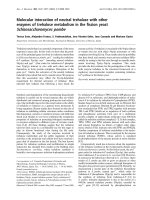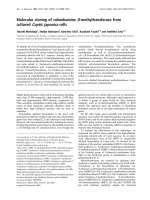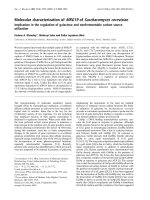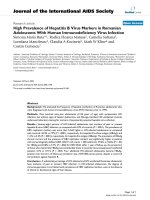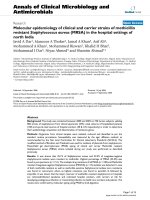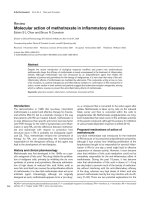Báo cáo y học: "Molecular epidemiology of hepatitis E virus infections in Shanghai, China" ppt
Bạn đang xem bản rút gọn của tài liệu. Xem và tải ngay bản đầy đủ của tài liệu tại đây (355.32 KB, 10 trang )
This Provisional PDF corresponds to the article as it appeared upon acceptance. Fully formatted
PDF and full text (HTML) versions will be made available soon.
Molecular epidemiology of hepatitis E virus infections in Shanghai, China
Virology Journal 2011, 8:541 doi:10.1186/1743-422X-8-541
Yumin Zhu ()
Fusheng Si ()
Xiaoming Yu ()
Ruisong Yu ()
Shijuan Dong ()
Fenfen Huang ()
Yuanshu Zhang ()
Zhen Li ()
ISSN 1743-422X
Article type Short report
Submission date 7 September 2011
Acceptance date 15 December 2011
Publication date 15 December 2011
Article URL />This peer-reviewed article was published immediately upon acceptance. It can be downloaded,
printed and distributed freely for any purposes (see copyright notice below).
Articles in Virology Journal are listed in PubMed and archived at PubMed Central.
For information about publishing your research in Virology Journal or any BioMed Central journal, go
to
/>For information about other BioMed Central publications go to
/>Virology Journal
© 2011 Zhu et al. ; licensee BioMed Central Ltd.
This is an open access article distributed under the terms of the Creative Commons Attribution License ( />which permits unrestricted use, distribution, and reproduction in any medium, provided the original work is properly cited.
Molecular epidemiology of hepatitis E virus
infections in Shanghai, China
ArticleCategory :
Short Report
ArticleHistory :
Received: 07-Sept-2011; Accepted: 02-Dec-2011
ArticleCopyright
:
© 2011 Zhu et al; licensee BioMed Central Ltd. This is an Open Access
article distributed under the terms of the Creative Commons Attribution
License, which permits unrestricted use, distribution, and reproduction in
any medium, provided the original work is properly cited.
Yumin Zhu,
Aff1 Aff2
Email:
Fusheng Si,
Aff1 Aff3
Email:
Dianjun Cao,
Aff4
Email:
Xiaoming Yu,
Aff1 Aff3
Email:
Ruisong Yu,
Aff1 Aff2
Email:
Shijuan Dong,
Aff1 Aff2
Email:
Fenfen Huang,
Aff1 Aff5
Email:
Yuanshu Zhang,
Aff3
Email:
Zhen Li,
Aff1
Corresponding Affiliation: Aff2
Phone: 86-21-62206391
Fax: 86-21-62207858
Email:
Aff1
Institute of Animal Science and Veterinary Medicine, Shanghai
Academy of Agricultural Sciences, Shanghai 201106, China
Aff2
Shanghai Key Laboratory of Agricultural Genetics and Breeding,
Shanghai 201106, China
Aff3
Nanjing Agricultural University, Nanjing, Jiangsu 210095, China
Aff4
Cent
er for Molecular Medicine and Infectious Diseases, Department of
Biomedical Sciences and Pathobiology, College of Veterinary
Medicine, Virginia Polytechnic Institute and State University,
Blacksburg, VA 24061-0913, USA
Aff5
Jiangxi Agricultural University, Nanchang, Jiangxi 330045, China
Abstract
Background
Hepatitis E virus (HEV) causes acute or fulminant hepatitis in humans and is an important public
health concern in many developing countries. China has a high incidence of HEV epidemics,
with at least three genotypes (1, 3, and 4) and nine subtypes (1b, 1c, 3b, 4a, 4b, 4d, 4g, 4h and 4i)
so far identified. Since genotype 3 and the newly identified subtype 4i have been exclusively
limited geographically to Shanghai and its neighboring provinces, the epidemiology of HEV
infections within the municipality, a major industrial and commercial center, deserves closer
attention.
Findings
A total of 65 sequences, 60 located within the HEV SH-SW-zs1 genome [GenBank:EF570133],
together with five full-length swine and human HEV genomic sequences, all emanating from
Shanghai, were retrieved from GenBank. Consistent with the primary role of genotype 4 in
China overall, analysis of the sequences revealed this to have been the dominant genotype
(58/65) in Shanghai. Six HEV subtypes (3b, 4a, 4b, 4d, 4h and 4i) were also represented.
However, although subtype 4a is the dominant subtype throughout China, subtype 4i (29/65) was
the most prevalent subtype among the Shanghai sequences, followed by subtypes 4d (10/65) and
4h (9/65). Subtypes 4h, 4i and 4d were found in both swine and humans, whereas 4b was found
only in swine and subtype 4a only in humans.
Conclusions
Six different swine and human HEV subtypes have so far been documented in Shanghai. More
molecular epidemiological investigations of HEV in swine, and particularly among the human
population, should be undertaken.
Keywords
Hepatitis E virus, Epidemiology, Shanghai municipality, Virus genotypes, Virus subtypes
Findings
Hepatitis E virus (HEV), the causative agent of acute or fulminant hepatitis in humans, is an
important public health concern in many developing countries. It is estimated that about two
billion people, or one-third of the world population, live in areas where HEV is endemic and are
therefore at risk of infection [1]. The disease is thought to be transmitted by the fecal-oral route,
usually through contaminated drinking water.
HEV is a non-enveloped, single stranded, positive-sense RNA virus belonging to the family
Hepeviridae. At least four mammalian HEV genotypes have been recognized [2]. Genotypes 1
and 2 are primarily associated with fecal-oral transmission among humans which, in developing
countries, can lead to waterborne jaundice epidemics. Genotypes 3 and 4 circulate in humans and
several animal species, and are associated with sporadic infection among humans in
industrialized countries [3]. In addition, two putative HEV genotypes, one from the Norway rat
(Rattus norvegicus) [4] and the other from wild boar [5], were recently reported.
A recent study in China, where there is a high frequency of HEV epidemics, has shown that
HEV seroprevalence among the general population was almost 40% and increased with age at a
rate of about 1% per year [6]. Furthermore, the number of fecal samples taken from young swine
that tested positive for HEV RNA ranged between 20–48% [7,8]. According to Zhu et al. [9], at
least three genotypes (1, 3 and 4) and nine subtypes (1b, 1c, 3b, 4a, 4b, 4d, 4g, 4h and 4i) of
human and swine HEV have so far been documented in China. Since genotype 3 and the newly
identified subtype 4i have been limited geographically exclusively to Shanghai and its
neighboring provinces, the municipality, as a major industrial and commercial center, is
deserving of close attention with respect to HEV infection epidemiology.
A total of 60 sequences located within the HEV SH-SW-zs1 genome (GenBank: EF570133] (44
between nt 6104 and nt 6256, and 16 between nt 6360 and nt 6509) together with five full-length
swine and human HEV genomic sequences, all derived from Shanghai, were retrieved from
GenBank as of June, 2011. All the sequences were aligned by Clustal W (version 1.8), and the
sequence percent identity was calculated using Lasergene (version 7.10; DNAstar). Phylogenetic
trees were constructed by the neighbor-joining method [10], based on the partial nucleotide
sequences of the ORF2 region. Bootstrap values were determined on 3,000 re-samplings of the
data sets [11]. The criteria used to define HEV genotypes or subtypes were adopted from Lu et
al. [12]. These authors demonstrated that an assemblage of 300–450 nucleotides at the 5' end of
the HEV ORF2 region was highly conserved and that phylogenetic analysis based on this region
provided accurate information about the genetic relationships between the HEV isolates and their
evolutionary state. The accession numbers of HEV reference sequences are shown in Figure 1.
Figure 1 Phylogenetic tree depicting genotypic/subgenotypic status of swine and human HEV
strains isolated in Shanghai. A) Analyses based on 5 full-length swine and human HEV genomic
sequences and 44 ORF2 sequences located between nt 6,104 and nt 6,256 within the HEV SH-
SW-zs1 genome [GenBank:EF570133]. B) Analyses based on 16 sequences located between nt
6,360 and nt 6,509 within the HEV SH-SW-zs1 genome. Percent bootstrap support is indicated
at each node. For each phylogeny, HEV subtypes were indicated on the outside of the square
brackets that define the HEV subtypes. Each branch is labeled with the host of the HEV isolate,
GenBank accession number and the year the strain was isolated. Reference sequences are labeled
with the prefix RE, the subtype of the sequence, the GenBank accession number and the
geographical source
Phylogenetic analysis indicated that six different HEV subtypes, i.e. 3b, 4a, 4b, 4d, 4h and 4i
(Figure 1) have so far been prevalent in Shanghai. Genotype 4 was the most highly represented
genotype among the 65 Shanghai sequences, and subtype 4i (29/65), followed by 4d (10/65) and
4h (9/65), the most prevalent subtypes. Of the 29 sequences classified as subtype 4i, four were of
human origin and 25 were from swine. HEV strain SH-SW-zs1 [GenBank: EF570133],
originating from swine and regarded as the Shanghai prototype HEV strain, belonged to subtype
4i. Furthermore, all the subtype 4i HEV strains so far reported in China were isolated in the
eastern part of the country, with 70% emanating from Shanghai, suggesting that subtype 4i
strains are perhaps indigenous to the municipality. Also included among this subtype was the
HEV strain, E067-SIJ05C [GenBank: AB369690], collected from a patient suffering from acute
hepatitis E in Japan who had traveled to Shanghai before the onset of the disease. Furthermore,
the partial sequence [GenBank: EU034710] of another subtype 4i strain isolated from a human
source in Shanghai was found to be virtually identical to a partial HEV sequence [GenBank:
EU034714] obtained from a sample of swine serum in eastern China during the same period,
suggesting that the isolates had a common origin [13]. To date, a total of nine subtype 4i HEV
strains identified from full genomic sequences deposited in GenBank have emanated either from
Japan or from Shanghai and neighboring Jiangsu Province. HEV strains of human origin
emanating from Japan (JYN-Shiz08L and JKS-Shiz07L) and from Shanghai (E067-SIJ05C)
were closely related to HEV strains isolated from wild boar (wbJGF08-1) [14,15] and from
swine (SAAS-FX17) [16], respectively. In addition, when phylogenetic clustering of subtype 4i
HEV strains was examined (data not shown), sequences from Japan and Shanghai were
positioned on different subtype 4i branches, suggesting that each of these two groups of strains
derived from different origins. When compared with other HEV subtype 4 strains across the
whole genome, only two specific amino acid substitutions were identified within the ORF1 of
subtype 4i. One substitution was located in the methyltransferase motif and the other in the
macro domain and might therefore influence HEV replication [17].
In this study, only subtypes 4h, 4i and 4d were found in both swine and humans, whereas
subtypes 4a and 4b were confined to either human or swine populations, respectively. According
to Zhu et al. [16], subtypes 4a and 4b HEV were capable of infecting both humans and swine.
Subtype 4a HEV is widely distributed among both the swine and human populations in China as
a whole but swine subtype 4a HEV has not been identified in Shanghai. A human subtype 4a
strain isolated in Shanghai, JYI-ChiSai01C [GenBank: AB197674] showed the highest
nucleotide similarity (94.0%) with a swine HEV strain Ch-S-1 from Jilin Province [GenBank:
EF077630], suggesting that 4a subtypes in Shanghai were also zoonotic. Human subtype 4b
HEV has a more limited distribution in China than the swine counterpart [16] and, so far, no
human subtype 4b strain has been reported in Shanghai. However, not every sample from
hepatitis E cases in Shanghai has been analyzed sufficiently and the possibility that human
subtype 4b exists among the population of the municipality cannot be excluded.
Genotype 3 HEV strains were geographically limited to Shanghai and neighboring provinces,
and seven sequences were classified into subtype 3b. No human genotype 3 HEV sequences
were among those from Shanghai although one strain, EChN22 [GenBank:HM439285], was
reported recently in neighboring Jiangsu Province [18]. The EChN22 isolate clustered closely
with Shanghai swine isolate FJ527832 and shared 97.2% nucleotide and 99.6% amino acid
homologies, which suggested that genotype 3 strains prevalent in Shanghai possibly participated
in human-swine transmission.
No genotype 1 HEV representatives were found in this study, possibly due to the limited number
(10/65) of human HEV sequences available.
In summary, six different HEV subtypes, i.e. 3b, 4a, 4b, 4d, 4h and 4i, have so far been shown to
be prevalent in Shanghai, with genotype 4 and subtype 4i the dominant forms. Only subtypes 4h,
4i and 4d were found in both swine and human hosts, whereas subtypes 4a and 4b were confined
to either human or swine populations, respectively. A recent epidemiological investigation has
shown that the average incidence of HEV RNA positives among the swine population of
Shanghai was approximately 20.0%, and that serum IgG positives reached 72.18% [19].
Hepatitis infection rates (all types) ranged between 15.0–35.0% among the younger population
and was 47.0% in older people. Furthermore, 39.4–69.7% cases of sporadic hepatitis E involved
co-infection with other hepatitis viruses [20]. Human hepatitis E infections have increased
significantly in recent years and, in Shanghai, have now become the third most likely cause of
hepatitis disease after hepatitis A and B [21]. Consequently, more molecular epidemiology
investigations of HEV among swine, and particularly human, populations should be undertaken
to assist in HEV control and prevention.
List of abbreviations
HEV, Hepatitis E virus; ORF, Open reading frame
Competing interests
The authors declare that they have no competing interests
Authors’ contributions
YMZ, FYS, RSY, YSZ and ZL participated in the study design, YMZ, SJD and FSS performed
the sequence analysis, and all authors participated in writing and revising the manuscript. All
authors have read and approved the final version.
Acknowledgments
We thank Dr John Buswell, Institute of Edible Fungi, for linguistic revision of the manuscript.
This study was supported by grants from the Shanghai Municipal Natural Science Foundation
(No. 09ZR1428100) and the Shanghai Academy of Agricultural Sciences Fund for Young
Scientists (2009(16)).
References
1. Chandra VTS, Kalia M, Jameel S: Molecular biology and pathogenesis of hepatitis E
virus. J Biosci 2008, 33:451–464.
2. Emerson SU, Anderson D, Arankalle A, Meng XJ, Purdy M, Schlauder GG, Tsarev SA:
Hepevirus. In Virus taxonomy VIIIth report of the ICTV. Edited by Fauquet CM, Mayo MA,
Maniloff J, Desselberger U, Ball LA. London:Elsevier/Academic Press; 2004:851–855.
3. Teo CG: The two clinico-epidemiological forms of hepatitis E. J Viral Hepat 2007,
14:295–297.
4. Johne R, Plenge-Bönig A, Hess M, Ulrich RG, Reetz J, Schielke A: Detection of a novel
hepatitis E-like virus in faeces of wild rats using a nested broad-spectrum RT-PCR. J Gen
Virol 2010, 91:750–758.
5. Takahashi M, Nishizawa T, Sato H, Sato Y, Jirintai, Nagashima S, Okamoto H: Analysis of
the full-length genome of a hepatitis E virus isolate obtained from a wild boar in Japan that
is classifiable into a novel genotype. J Gen Virol 2011, 92:902–908.
6. Li RC, Ge SX, Li YP, Zheng YJ, Nong Y, Guo QS, Zhang J, Ng MH, Xia NS:
Seroprevalence of hepatitis E virus infection, rural southern People's Republic of China.
Emerg Infect Dis 2006, 12:1682–1688.
7. Li Z, Yu SS, Dong SJ, Zhu YM, Si FS, Shen SY, Jiang ZQ, Yu RS, Zou SX. Reduced
prevalence of genotype 3 HEV in Shanghai pig farms and hypothetical homeostasis of
porcine HEV reservoir. Vet Microbiol 2009, 137:184–189.
8. Geng J, Wang L, Wang X, Fu H, Bu Q, Liu P, Zhu Y, Wang M, Sui Y, Zhuang H. Potential
risk of zoonotic transmission from young swine to human: seroepidemiological and genetic
characterization of hepatitis E virus in human and various animals in Beijing, China. J
Viral Hepat 2011, 18: e583-590. doi: 10.1111/j.1365–2893.2011.01472.x.
9. Zhu YM, Dong SJ, Si FS, Yu RS, Yu XM, Zou SX, Li Z: Swine and human hepatitis E
virus (HEV) infection in China. J Clin Virol 2011, 52:155–157.
10. Saitou N, Nei M. The neighbor-joining method: a new method for reconstructing
phylogenetic trees. Mol Biol Evol 1987, 4: 406–425.
11. Felsenstein J: Confidence limits on phylogenies: an approach using the bootstrap.
Evolution 1985, 783–791.
12. Lu L, Li C, Hagedorn CH: Phylogenetic analysis of global hepatitis E virus sequences:
genetic diversity, subtypes and zoonosis. Rev Med Virol 2006, 16:5–36.
13. Zhang W, Shen Q, Mou J, Gong G, Yang Z, Cui L, Zhu J, Ju G, Hua X: Hepatitis E virus
infection among domestic animals in eastern China. Zoonoses Public Hlth 2008, 55:291–298.
14. Sato Y, Sato H, Naka K, Furuya S, Tsukiji H, Kitagawa K, Sonoda Y, Usui T, Sakamoto H,
Yoshino S, Shimizu Y, Takahashi M, Nagashima S, Jirintai, Nishizawa T, Okamoto H: A
nationwide survey of hepatitis E virus (HEV) infection in wild boars in Japan:
identification of boar HEV strains of genotypes 3 and 4 and unrecognized genotypes. Arch
Virol 2011, 156:1345–1358.
15. Takahashi K, Kitajima N, Abe N, Mishiro S: Complete or near-complete nucleotide
sequences of hepatitis E virus genome recovered from a wild boar, a deer, and four patients
who ate the deer. Virology 2004, 330: 501–505.
16. Zhu YM, Yu XM, Si FS, Zhang YS, Zou SX, Li Z: Full-genome sequence analysis of a
hepatitis E virus (HEV) strain SAAS-FX17 and potential disease severity determinants
identification between genotype 3 and genotype 4 HEV strains. Virology 2011, submitted
17. Ahmad I, Holla RP, Jameel S. Molecular virology of hepatitis E virus. Virus Res 2011,
doi:10.1016/j.virusres.2011.02.011.
18. Yan Y, Zhang W, Shen Q, Cui L, Hua X: Prevalence of four different subgenotypes of
genotype 4 hepatitis E virus among swine in the Shanghai area of China. Acta Vet Scand
2008, 50:12.
19. Zhou JP, Sun QY, Liu PH, Xue X, Li KH, Lu J, Zhang WY, Qi XY: Serological
investigation on hepatitis E of several animal species in Shanghai. Prog in Vet Med 2006,
27:85–88. (Article in Chinese)
20. Li YT, Zhu YY, Shen WG, Zhang AX, Zhang JM, Ren H, Yuan GP, Gu LJ: The analysis of
HEV genotypes isolated from sporadic acute hepatitis E in Shanghai. Virologica Sinica
2002, 17:106–109.
21. Kang LY, Pan QC, Jin ZC, Zhou TK, Fang H, Xue YL, Zhang W, Jiang Q, Zhu QR, Yao
GB, Zhang JM, Zheng XH: The molecular investigation of hepatitis C and E virus infection
in Shanghai. J Prev Med 1995, 7:438–441.
1
1
2
3
4
5
6
7
8
9
10
11
12
13
14
15
16
17
18
19
20
21
22
23
24
25
26
27
28
29
30
31
32
33
34
35
36
37
38
39
40
41
42
43
44
45
46
47
48
49
50
51
52
53
Figure 1
2
Figure 1. Phylogenetic tree depicting genotypic/subgenotypic status of swine and 54
human HEV strains isolated in Shanghai. 55
A) Analyses based on 5 full-length swine and human HEV genomic sequences and 44 56
ORF2 sequences located between nt 6104 and nt 6256 within the HEV SH-SW-zs1 57
genome [GenBank:EF570133]. 58
B) Analyses based on 16 sequences located between nt 6360 and nt 6509 within the HEV 59
SH-SW-zs1 genome 60
Percent bootstrap support is indicated at each node. For each phylogeny, HEV subtypes 61
were indicated on the outside of the square brackets that define the HEV subtypes. Each 62
branch is labeled with the host of the HEV isolate, GenBank accession number and the 63
year the strain was isolated. Reference sequences are labeled with the prefix RE, the 64
subtype of the sequence, the GenBank accession number and the geographical source. 65
66


